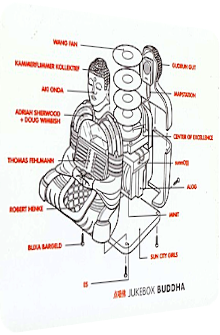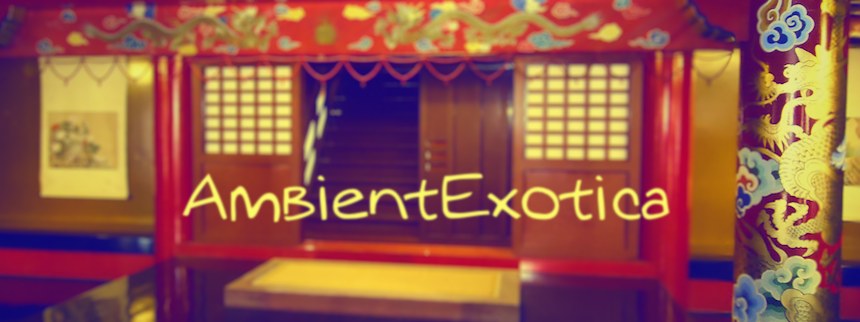
Various Artists
Jukebox Buddha
2006
The compilation Jukebox Buddha is all about the loops and layers of the meditative Buddha Machine, a small box available in multiple colors that plays sumptously soporific Ambient loops through a small speaker. It was invented by Christiaan Virant and Zhang Jian, the Beijing-based music duo FM3 in 2005. In 2006, everyone thought that this small box would be a short-term success for the duo or just the next hype. Years later, the success of the Buddha Machine hasn't declined in the slightest. in fact, its scope has broadened and shifted away from the box-like appearance to various multimedia and iPad apps, now allowing the user to merge his favorite loops and create new soundscapes. What remains, though, is the remix culture around the box. The Jukebox Buddha compilation was the first of its kind. It was released on the Staubgold label in Berlin and features several mixes and reinterpretations of various European and Asian artists, among them Thomas Fehlmann, Adrian Sherwood, Aki Onda, sunnO))) and Robert Henke whose cut was taken off his album Layering Buddha released in the same year. What all remixes on this compilation have in common is their thick atmosphere and their experimental Ambient approach. The mood shuttles between spell-binding brightness, abyssal deepness and dusky gloominess, resembling exactly the various loops of the original Buddha Machine. Some artists favor presenting the loops boldly in the limelight, while others try to hide them in the background by building an entirely new track around them. If you haven't realized by now, this is no soulless Buddha lounge bar compilation for hipsters with a few Chinese clichés thrown in, but a sophisticated experimental Ambient album! The quality of all tracks is top notch, and compilations of all kinds don't reach this level quite often. I'll check out the majority of the various tracks below.
The Buddha mélange starts fittingly with a track by a Chinese artist from Beijing: Wang Fan's Xuanzhuan De Tuoluonidi. A field recording of crickets and a Chinese female voice greet the listener. So far, the Buddha Machine loop isn't yet introduced, but dark drones, howling wind, frizzles and staccato synth pulses are intensified soon after, while a synth reminiscent of a traditional Chinese flute is introduced. When the pumping beats set in, the song already reached a peak in density. The best thing about this song is the permanent contrast between arcane mystique and a whirling maelstrom of synths and drones. The Buddha Machine loop is deeply embedded in the mix and hardly recognizable. A great starting point and a superb tune overall. Kammerflimmer Kollektief's Gammler, Zen + Hohe Berge is much more experimental, and if you're familiar with their avantgarde experiments in music, this shouldn't be a surprise to you. A permanent purposeful background noise points to a lo-fi live recording, and instead of using a loop of the FM3's machine, the trio uses their instruments to mimic it. Their tune merges contemplative Chinese music and its related quiescence and peaceful flow with a surprisingly melodious Krautrock/hippie movement flavor. Fragile chords, flittering strings and Kraut guitars are intertwined with tense percussion and a quiet intro and outro. Next is Aki Onda who delivers a magnificent track for the compilation: The Buddha In New York consists of a 20-second electric guitar loop and an interwoven, iridescent Buddha Machine loop. A field recording of a New York-based caféteria or restaurant is added and depicts the bustling activity and chattering of the guests. The loop is both played in this surrounding and added as a post-effect. The whole build-up is very loop-based and quite schematic overall, but its mixture of pauses and overdriven guitar is very attractive to my ears. Karma Cola by Dub legends Adrian Sherwood + Doug Wimbish interweaves various snippets and filtered samples over a slow breakbeat with saxophone fade-ins and traversing preaches. This is certainly not for everyone, as it is rather enigmatic and experimental.
The following Liquid Buddha by Thomas Fehlmann is a killer track. The Buddha Machine loop is instantly recognizable and is embedded in terrifically cavernous and echoey, spectral synth towers. On high volumes, I always get the feeling of being swallowed. Best of all is that Fehlmann delivers this track once again under the name of Atlas 1 on his 2007 longplayer Honigpumpe where the soundscape is surrounded by dubby basslines. As mentioned briefly before, a track off Robert Henke's Layering Buddha is also featured on this compilation as Layer 02 offers the most faithful reproduction of the layer with the same name. It is repeated incessantly, and its eariness is enhanced by quavering sizzles and fragmented synth backings. Henke proves that this supposedly cold, precise and reduced approach can actually work marvelously. The powerful gloomy peacefulness of the loop is only slightly enhanced and altered. Another beautiful track is Gudrun Gut's Rendering Buddha. The breeze-like whispering setting of the song is very reduced while her voice is upfront the mix. Gut's lyrics are a dedicated devotion to the Buddha Machine, and the glistening, hazy backing bells are a nice counterpoint. Despite being similarly experimental as Karma Cola, Gut's contribution is more coherent and successful in creating a mystical aura, even though there are equally lively fragments and buzzes added. The one-time-affair super group Center Of Excellence provides a comic relief by coming up with an advertisment track complete with Chinese temple gongs, nerdy sound effects of all kinds and the listing of beneficial attributes that help users of the Buddha Machine in most unexpected ways – very tongue-in-cheek. Andrew Pekler, Hanno Leichtmann and Jan Jelinek are the guys behind the project, and while all them are known for their deep, more serious projects, they take a break and deliver a delightfully funny interlude.
The best track of the compilation is delivered by sunnO))), and their tone is absolutely mellow, slightly mystical and loaded with shimmering warmth. BP//Simple begins with trembling drones, organic pulses and glitzy static noise. This mind-blowing cocktail is kept up for several minutes. A Buddhist preacher is added who was already used on Sherwood's and Wimbish's Karma Cola. The various drone layers are very deep, and yet the song feels lively, bustling and organic. The permanent static noise isn't distracting or nerve-racking, but add depth and plasticity to the mix. A must for fans of sunnO))), even for those who aren't fond of the band's regular release. Alog's The Dragon Lies Listening is a field recording track that takes place on a playground of laughing children. A snoring dragon, chopped layers of a singing trio and breaking branches make this an experimental, slightly cheeky but also heavenly track. But where's the Buddha Machine sample? Maybe it is placed in the last minute of the track which consists of anything but sample fragments that are reminiscent to a whole generation‘s channel switching via remote control. The last track that is close to my heart and interesting is the Australian duo Minit's Winged Life. In contrast to their dark minimal drone album Music of 1999, the track is glowing! It contains cricket sounds, static noise drones and an utterly gorgeous, warm guitar melody. It is Chinese in style, quite hypnotic and the driving force of this track that even fends off the high frequency buzzes. A superb track.
Jukebox Buddha is a splendid compilation, and though it didn't make it to a regular series, its impact on the remix culture helped to establish a healthy scene of people who are using the Buddha Machine loops for their music projects. From all over the world do people send in their mixes to creators, and the style varies all the time. And let's not forget about the box itself that still delivers beautiful loops that help people during work hours orbefore going to sleep … at work. If you are afraid of repetition and the use of the same formula, you don't need to worry or feel skeptical, for Jukebox Buddha presents a wealthy variety of artists, loops, moods and aesthetic viewpoints. Highly recommended for its occasional Asian flavor and the balanced mixture of darkness and brightness.
Further reading:
The official Twitter account of the Buddha Machine is @buddhamachine. Several times a week, new Buddha Machine-related apps, photos, artworks and remixes are introduced and retweeted.
Ambient Review 066: Various Artists – Jukebox Buddha (2006). Originally published on May 2, 2012 at AmbientExotica.com.
